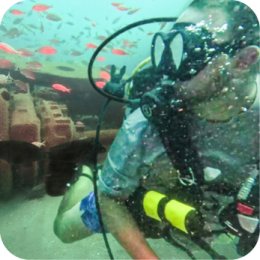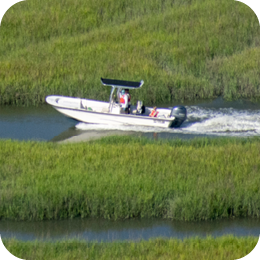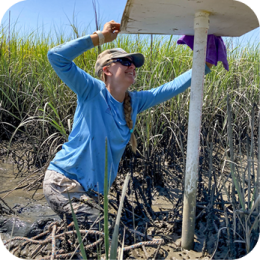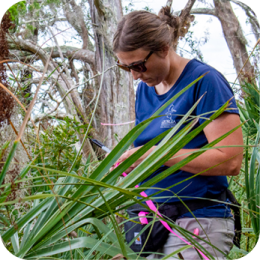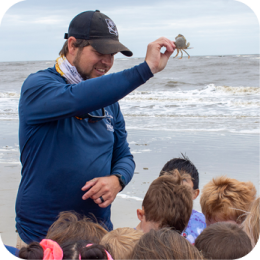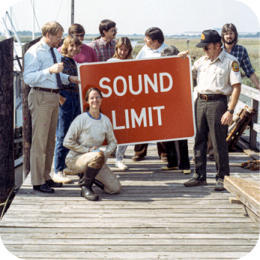Overview
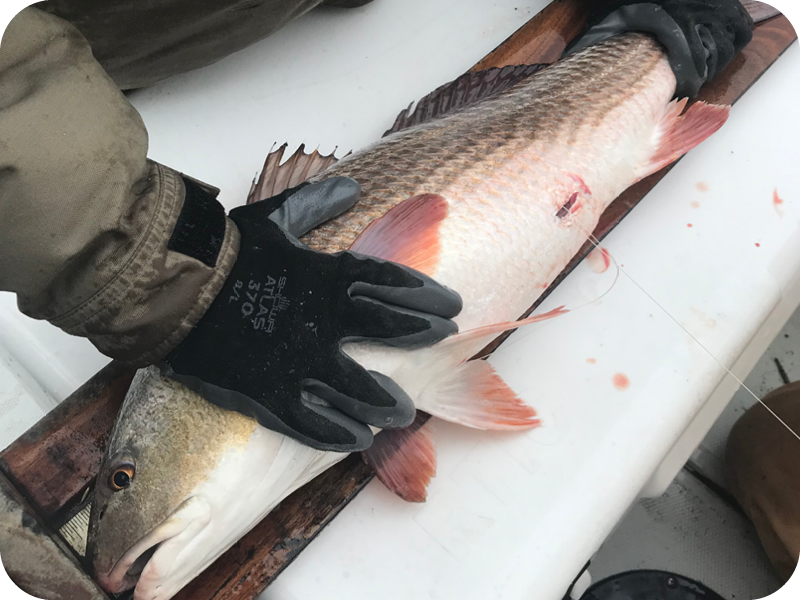 CRD began an autonomous acoustic telemetry project to study the movement of Red Drum beginning in Wassaw Sound in 2019 and later St. Simons Sound in 2021. This project was started with the goal of learning about behavior, primarily the age and size of Red Drum as they emigrate from estuaries and move offshore. This includes information about habitat use within estuaries and fate of Red Drum in sounds. Autonomous acoustic telemetry is the use of stationary, passive receivers (Vemco™ VR2W) to monitor the movements of animals tagged with coded acoustic transmitters (Vemco™ V13 & V16) 24 hours/day. These tags are internally implanted and can have battery lifespans of up to 6 years. Fewer telemetry tags are needed to collect a similar amount of data as compared to conventional tags.
CRD began an autonomous acoustic telemetry project to study the movement of Red Drum beginning in Wassaw Sound in 2019 and later St. Simons Sound in 2021. This project was started with the goal of learning about behavior, primarily the age and size of Red Drum as they emigrate from estuaries and move offshore. This includes information about habitat use within estuaries and fate of Red Drum in sounds. Autonomous acoustic telemetry is the use of stationary, passive receivers (Vemco™ VR2W) to monitor the movements of animals tagged with coded acoustic transmitters (Vemco™ V13 & V16) 24 hours/day. These tags are internally implanted and can have battery lifespans of up to 6 years. Fewer telemetry tags are needed to collect a similar amount of data as compared to conventional tags.
Acoustic telemetry studies can provide some of the same types of information as conventional tagging studies with the added benefit of providing more detailed information about specific movements, seasonality, aggregation areas, home ranges, and interstate migrations. Collecting information from telemetry tags does not rely on anglers to recapture fish that have been tagged. Instead, information is logged by underwater receivers deployed as part of a study. Receivers are retrieved, maintained, and downloaded routinely by project personnel. These receivers can be placed within the study area or can be deployed as part of a separate study in a different region.
Tags and receivers are compatible across different studies. For example, a fish tagged in Georgia can be tracked by receivers deployed by other researchers in South Carolina or Florida, if the fish migrates into those areas. This makes the technology useful for studying both local movements as well as long range migrations.
Capture and Implementation Techniques
Fish are captured using conventional hook and line techniques to minimize handling stress. Once caught, fish are placed in a temporary holding ring, then brought onboard for implantation. Fish are placed in a V-shaped cradle and submerged in a live well system that keeps their head and gills underwater but exposes their ventral surface. A scalpel is used to make a 3-4 cm incision mid-body of the fish and slightly offset from the ventral midline. Then, a sterilized acoustic transmitter is inserted into the peritoneal cavity and the incision is closed with an absorbable Vicryl™ suture. After surgery, fish are tagged with a conventional dart tag that includes a unique number and instructions for reporting in the event of an angler recapture. Finally, fish are evaluated for condition and released near the original capture site.
Study Area
In fall 2019, an array of receivers was established in Wassaw Sound to continuously monitor fish movements throughout estuary. Since then, 12-14 receivers were operational in the Wassaw Sound array. An additional receiver array has been established in St. Simons Sound, but results are not yet available.
Receivers were deployed using a 2.4 m (8 ft) piece of 5mm (2 in) aluminum channel tube bolted directly to a piling or fixed structure, approximately 1 m above the mean low water mark. The receiver was then bolted to the bottom of the channel tube and submerged. This technique allowed receivers to be maintained and serviced routinely from small vessels. Additional receivers may be added to the array as needed to fill in any coverage gaps as the project continues. Deployed receivers continuously monitored the area for telemetered fish and when those fish are present, receivers recorded the date, time, and unique ID for each fish within range (approx. 300 m).
In addition to the Wassaw array CRD maintains an array of 24 autonomous acoustic receivers in Georgia’s nearshore and offshore waters along St. Simons Island. The purpose of the Coastal Receiver Array (CRA) project is to track the movements of coastal migratory animals tagged with Vemco™ telemetry tags. The array consists of a nearshore component where 8 VR2W receivers are attached to navigation buoys along the St. Simons shipping channel and an offshore component consisting of 16 VR2W receivers anchored to the seafloor, ranging from 6-24 miles offshore. This array is beneficial to the Wassaw project because it will capture any movements of Red Drum that move south from the Wassaw array.
Regional Collaborations
Fish movement is often unpredictable, and the direction or distance fish travel can be unexpected. Fortunately, CRD is an active participant in the FACT Network; a collaborative partnership among researchers representing 99 different organizations and 283 members, all conducting acoustic telemetry research. Members of FACT collaborate on projects, share data and exchange design concepts on a variety of projects including site fidelity studies, habitat preference, and investigations into seasonal migrations of fishes. Collaborators all agree to use similar equipment, locate receivers in priority areas and share data with the proper owners (recognized as the person that deployed the tag). By participating in the consortium, researchers have access to a network of more than 1,500 receivers distributed throughout freshwater and marine habitats (both inshore and offshore) ranging from the Dry Tortugas to the mid-Atlantic. Any movements of Red Drum outside of Georgia will likely be captured and recorded by another participating researchers’ array and shared.
The first download of array receivers was conducted spring 2020 and periodically after that. Data from this study will help improve the understanding of habitat use, seasonality, and movements of Red Drum in coastal Georgia. This project will be used as a template for future acoustic projects on other species and/or other systems throughout Georgia. Specifically, for Wassaw Sound, the Escapement Project will give us an idea about the fate and behavior of Red Drum as it relates to angler activity. This information, in conjunction with information from the Cooperative Angler Tagging Program, will help us improve our management efforts.
Questions?
Contact Marine Biologist Chris Kalinowsky at chris.kalinowsky@dnr.ga.gov or by calling (912) 264-7218.


